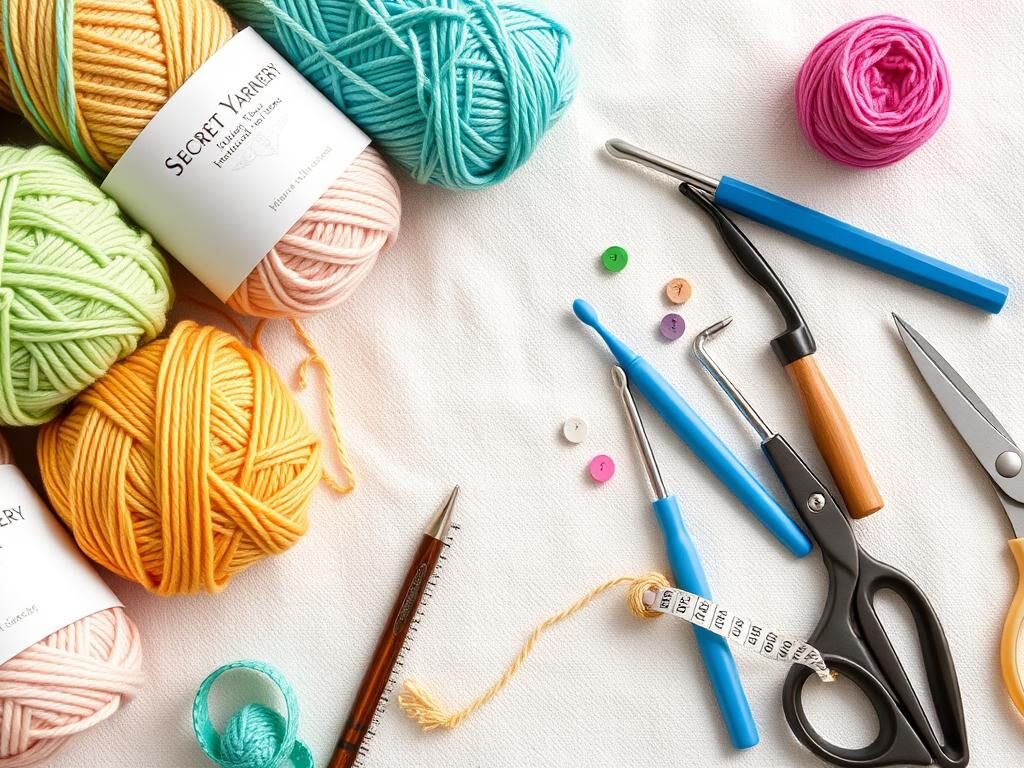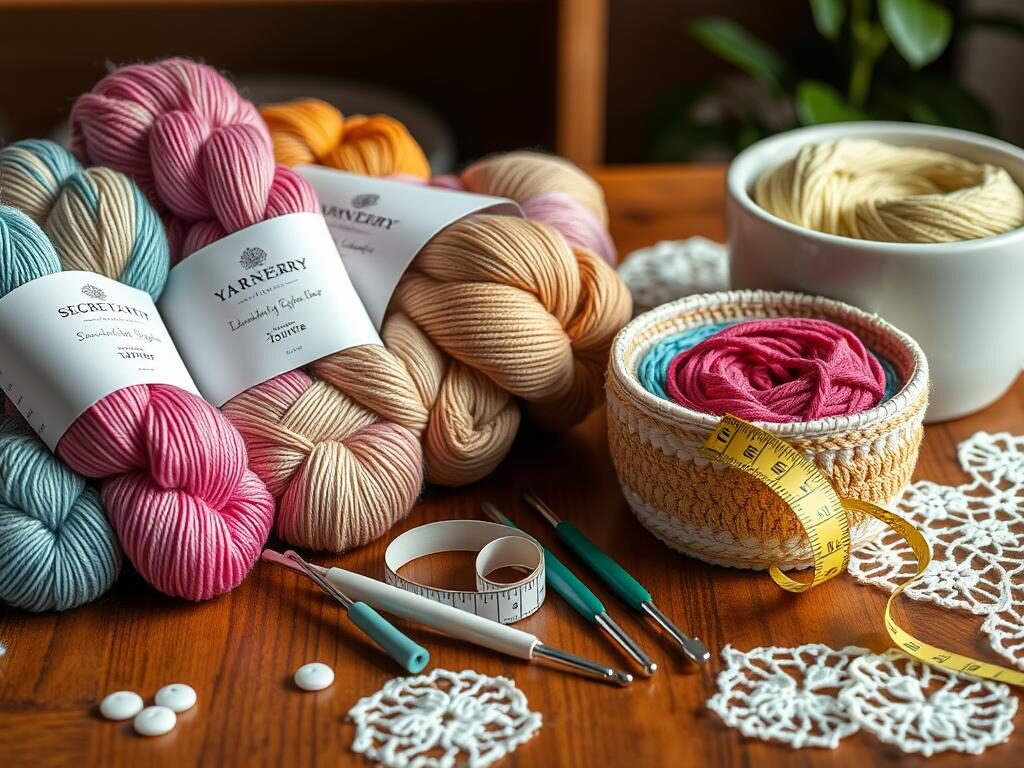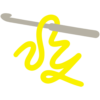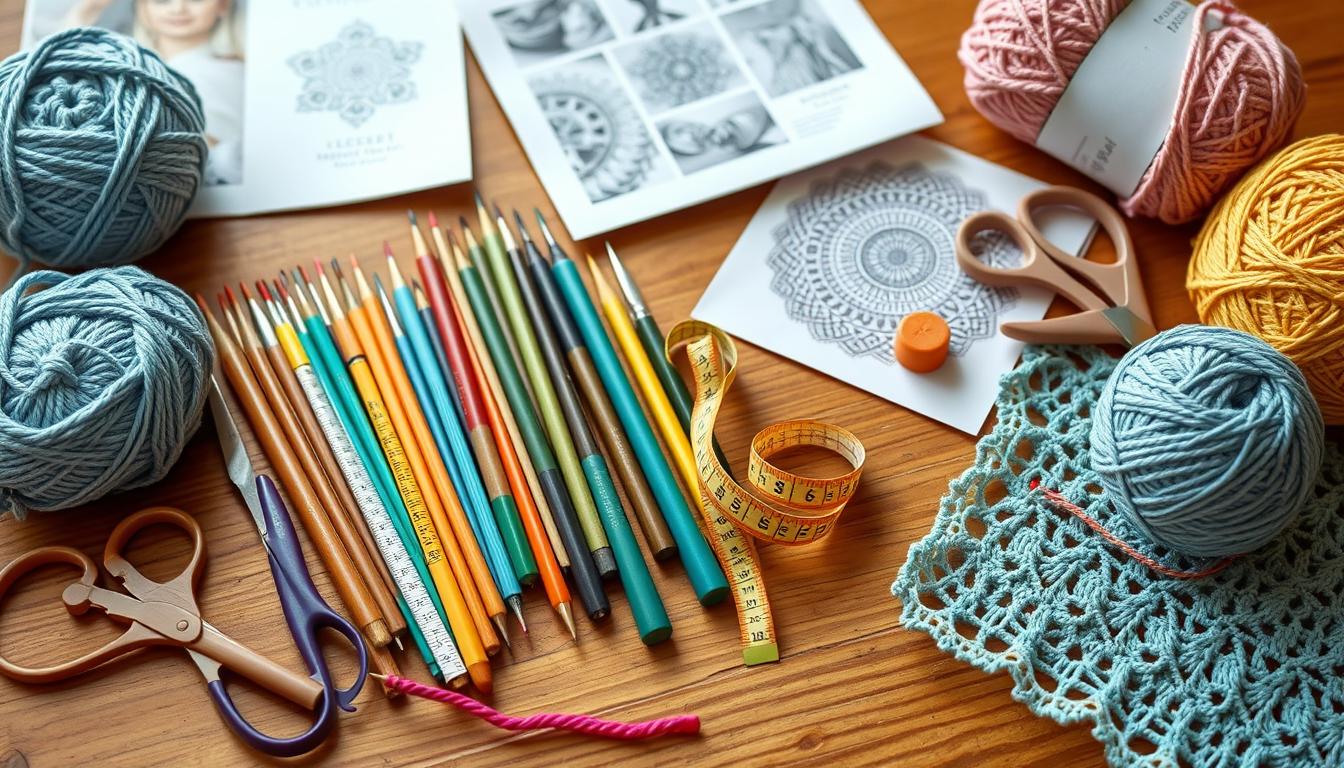Essential Crochet Tools for Beginners: Get Started!
Wondering what you need to start crocheting? You’re in the right spot. This article lists the essential crochet supplies and tools for beginners. The two key tools are the crochet hook and the yarn. Without these, you can’t crochet anything!
You’ll also need a yarn needle, scissors, stitch markers, and a measuring tape. These are basic supplies for your crochet toolkit. Whether you’re new to crochet or looking to expand your collection, this article has you covered.
Key Takeaways
- There are 7 must-have crochet supplies listed for beginners.
- Crochet hooks come in different materials, shapes, and sizes.
- Beginners are recommended to start with a smooth, medium-weight yarn in a lighter color.
- Stitch markers are essential tools for marking stitches as you crochet.
- A flexible measuring tape is recommended for measuring crochet projects.
Crochet Hooks: The Essential Tool
The crochet hook is key for crocheting. They come in many materials, shapes, and sizes. Knowing how to pick the right one can make your projects better and your crocheting more fun.
Material
Crochet hooks are made from materials like aluminum, plastic, bamboo, and wood. Aluminum hooks are light and cheap. Wooden and bamboo hooks are warm and comfy, good for those with hand pain. Plastic hooks are light and cheap, great for big hooks. Metal hooks, like steel, are for fine yarns and not for beginners.
Shape
There are different shapes of crochet hooks. Inline hooks are good for grabbing yarn easily. Tapered hooks are fast and less likely to split yarn. As a beginner, try different shapes to find what feels best.
Size
The hook’s size is based on its circumference. The size you need depends on the yarn and pattern. Thin yarns need small hooks, while thick yarns need big ones. Patterns usually tell you the hook size to use. A 4mm or G/6 hook is a good start for beginners.
| Hook Material | Pros | Cons |
|---|---|---|
| Aluminum | Lightweight, inexpensive | None |
| Plastic | Lightweight, inexpensive | None |
| Bamboo | Lightweight, warm to the touch | Yarn may catch on the surface |
| Wood | Lightweight, warm to the touch | Yarn may catch on the surface |
| Metal (Steel) | Durable, suitable for fine yarns | Not recommended for beginners |
Choosing the right crochet hook is crucial. By knowing about materials, shapes, and sizes, you can pick the best one. This will make your projects better and crocheting more enjoyable.
Yarn: Choosing the Right Fiber
Choosing the right yarn is key when crocheting. Yarn weights range from lace to jumbo. The weight you pick depends on the pattern and your taste. Beginners often start with medium or bulky yarns, as they’re easier to see and work with.
Weight
The yarn’s weight is marked on the label. It’s important to check this. Here’s a quick guide to yarn weights:
- Lace Weight (#0): 16+ wraps per inch
- Fingering Weight (#1): 14-16 wraps per inch
- Sport Weight (#2): About 12 wraps per inch
- DK/Light Worsted Weight (#3): 10-11 wraps per inch
- Worsted/Aran/Heavy Worsted Weight (#4): 8-9 wraps per inch
- Bulky Weight (#5): Average of 7 wraps per inch
- Super-Bulky Weight (#6): 5-6 wraps per inch
- Jumbo Weight (#7): 4 wraps per inch or fewer
Fiber Type
Yarns come in natural and synthetic fibers. Beginners often start with acrylic or wool-blend yarns. They’re easy to work with, durable, and can be machine-washed. Cotton yarns are stiffer, while silk is better for experienced crocheters.
Popular fibers include:
- Cotton: Lightweight, durable, and absorbent, great for washcloths and clothing.
- Wool: Naturally elastic, good for stitch control and resisting wrinkles.
- Acrylic: Lightweight, strong, colorfast, and hypoallergenic, but not as breathable as natural fibers.
Color
Choosing the right color is fun and creative. Beginners should start with lighter, neutral colors. This makes it easier to see stitches. Avoid dark or textured yarns for beginners. As you get better, try brighter, bolder colors.
Remember, the key to crocheting is to enjoy the yarn you’re working with. Don’t be afraid to try different fibers and colors.
Tapestry Needles: Weaving in Ends
Tapestry needles, also known as yarn needles or darning needles, are key for crocheters. They have blunt tips for weaving in ends and sewing crochet pieces together. You’ll find them in various shapes and sizes, with straight and bent-tip needles being the most common.
Choosing the right tapestry needle is crucial. Make sure the needle’s eye is big enough for your yarn. Metal needles are better than plastic because they’re more durable and easier to use.
Types of Tapestry Needles
- Tapestry needles come in different varieties such as plastic and metal.
- They can have straight-tip or bent-tip designs to accommodate different project needs.
- Tapestry needles come in a range of sizes, from large to small, to suit various yarn weights.
Material Matters
Plastic tapestry needles are recommended for kids due to being inexpensive, while steel tapestry needles are more durable and slick, preferred for long-term use.
Weaving in Ends
Weaving in the ends of your crochet project is key to prevent unraveling. Most crocheters do this before blocking and seaming. It’s best to weave horizontally through the base of stitches and vertically through taller stitches for a secure finish.
| Weaving Technique | Recommendation |
|---|---|
| Weaving in Bulky Yarns | Splitting bulky yarns into plies and weaving them separately can help hide bulkiness. |
| Avoiding Puckering | Weaving the yarn too tightly can cause fabric puckering, so it’s important to be cautious. |
| Preventing Unraveling | Weaving the ends in and out of the fabric in multiple directions ensures security and prevents unraveling over time. |
Using tapestry needles for weaving in ends is the best way to achieve a professional finish on your crochet projects. By selecting the right needle and following proper techniques, you can ensure your work looks polished and secure.
Scissors: A Must-Have Trimming Tool
As a crocheter, having good crochet scissors is crucial. They are essential for cutting yarn and cleaning up your crochet projects. Look for small, sharp scissors that fit in your project bag.
There are scissors made just for crocheters, like yarn snips or stork scissors. These sharp scissors for crochet make trimming crochet projects and cutting yarn easier. Their small size and sharp blades help you cut excess yarn or tidy up your work.
Don’t use regular household scissors for crochet. While they might do, crochet scissors are better. They make cutting smoother and more efficient. Get a good pair, and you’ll see how much better it is!
| Feature | Benefit |
|---|---|
| Compact Size | Easily fits in your crochet project bag |
| Sharp Blades | Precise cutting for trimming yarn and projects |
| Crochet-Specific Design | Optimized for the unique needs of crocheters |
A good pair of crochet scissors is key for your craft. They improve the quality and speed of your crochet projects. So, get a pair that will help you and enjoy easy trimming of crochet projects and cutting of yarn.
Stitch Markers: Keeping Track of Your Progress
As a beginner crocheter, stitch markers are key. They help you track your stitches and keep your work on track. These small markers are crucial for mastering crochet.
For crochet, look for locking or split ring stitch markers. They easily slide onto your hook. This makes it easy to mark the start of a round or any special stitches.
Starting out? You can make your own stitch markers with paper clips or bobby pins. But, for a better look and ease, get a set of crochet stitch markers. Brands like Mayflower and KnitPro offer a wide range, from basic to stylish.
“Stitch markers are a game-changer when it comes to marking stitches and tracking progress in your crochet projects. They take the guesswork out of keeping count and ensure your work stays neat and tidy.”
Stitch markers are vital for any crochet project. They make your journey smoother and more fun. So, add them to your toolkit – your future self will appreciate it!
Stitch markers come in many types. Split ring stitch markers are easy to use. Locking stitch markers hold tight. You can also find them in many colors and shapes to match your style.
Whatever stitch markers you pick, they’ll be essential. So, get a new set today and elevate your crochet skills.
Crochet Instruments and Equipment Each Newbie Ought to Have
Starting with crochet means more than just hooks, yarn, and scissors. You’ll also need some extra tools and accessories. These must-have crochet accessories include a crochet hook case, a crochet project bag, and a yarn bowl.
A crochet hook case helps organize your growing hook collection. They come in different sizes and materials. This keeps your beginner crochet tools safe and tidy.
A crochet project bag or tote is also essential. It keeps your yarn, hooks, and other must-have crochet accessories together. This makes it easy to carry your crochet starter kit around.
A yarn bowl is another game-changer for beginner crochet tools. It holds your yarn, preventing it from tangling. This simple crochet accessory makes crocheting easier, especially on big projects.
| Crochet Accessory | Benefit |
|---|---|
| Crochet Hook Case | Organizes and protects your crochet hooks |
| Crochet Project Bag | Keeps all your essential crochet supplies together |
| Yarn Bowl | Prevents yarn from becoming tangled |
While these must-have crochet accessories aren’t a must for beginners, they’re worth it. They make crocheting more fun and efficient. Adding these tools to your crochet toolkit will enhance your experience.

Measuring Tape: Gauging Your Tension
As a crocheter, having a reliable measuring tape is key. It lets you measure your crochet projects accurately. This ensures they are the right size. But it’s also vital for checking your gauge, a critical step in any pattern.
When starting a new project, making a gauge swatch is crucial. It checks if your stitches and rows match the pattern’s needs. For example, a four-inch swatch should have 14 stitches and 14 rows. If it doesn’t, you might need to change your hook size.
A flexible, retractable measuring tape makes measuring easy. Wrap it around your swatch for precise measurements. For instance, a swatch might show 16 stitches and 12 rows in four inches. After wet blocking, it could measure 13 stitches and 13 rows, showing how blocking affects measurements.
Many beginners skip the gauge swatch, thinking it’s not needed. But this can make projects too big or too small. Gauge swatches are key to getting the right size, saving time and avoiding frustration.
So, when buying essential crochet tools, don’t forget a flexible measuring tape. It’s a small investment that greatly improves your crochet projects.
“Gauge swatches are incredibly useful for clothing, home decor projects, and pattern testing and design.”
| Measurement | Before Blocking | After Blocking | After Machine Drying |
|---|---|---|---|
| Stitches per 4 inches | 16 | 13 | 16 |
| Rows per 4 inches | 12 | 13 | 14 |
Additional Accessories for Convenience
As a crocheter, having the right tools is key. While the basics like a crochet hook and yarn are essential, other accessories can make a big difference. Let’s look at some tools that can improve your crochet experience.
Crochet Hook Case
Keeping your crochet hooks organized is easy with a crochet hook case or organizer. These come in many materials and designs. They let you store all your hooks in one spot. Whether you need something small or large, having a place for your hooks is handy.
Crochet Project Bag
A crochet project bag or tote is a must-have. These bags hold all your crochet stuff, like your current project. You can find cozy bags or stylish totes to match your style and needs.
Yarn Bowl
A yarn bowl can solve the problem of yarn tangles. These bowls, made of ceramic or wood, keep your yarn tidy. This lets you crochet smoothly without worrying about tangles.
Adding these accessories can make your crochet journey better. With the right tools, you’ll crochet more easily and efficiently. This lets your creativity shine.

Conclusion
Now you know what crochet supplies for beginners you need. Start with the basics like a hook, yarn, scissors, and stitch markers. As you get better, add more tools to your collection.
With the right essential crochet tools and practice, you’ll make beautiful projects. Happy getting started with crochet!
Keep trying new things like different hook sizes and yarn types. Each project is a chance to learn and grow. Enjoy every step of the way.
Whether you crochet for fun, to make gifts, or start a business, the right supplies matter. So, get your tools ready, find inspiration, and let your creativity shine. With the basics covered, the possibilities are endless, and you’ll love making your own things.
FAQ
What are the two most important crochet tools?
The two most important tools are the crochet hook and the yarn.
What materials are crochet hooks made from?
Hooks are made from materials like aluminum, plastic, bamboo, and wood.
What are the different shapes of crochet hooks?
Hooks come in shapes like inline and tapered.
How do I determine the size of crochet hook I need?
The hook size depends on the yarn and pattern. Your pattern will tell you the needed size.
What are the different weights of yarn?
Yarn weights range from lace (#0) to jumbo (#7).
What type of yarn is best for beginners?
Beginners should start with medium or bulky yarn. It’s easier to see and work with.
What are tapestry needles used for?
Tapestry needles are for weaving ends and sewing crochet pieces together.
What should I look for when choosing crochet scissors?
Choose small, sharp scissors that fit in your project bag.
What are stitch markers used for in crochet?
Stitch markers mark your stitches. They help with round starts, row ends, and tracking increases and decreases.
What other crochet accessories can be useful?
Useful accessories include a hook case, project bag, and yarn bowl.
Source Links
- The 7 Essential Crochet Supplies that Beginners Actually Need – https://sarahmaker.com/crochet-supplies/
- 5 Must-Have Crochet Materials for Beginners – https://thewoobles.com/blogs/news/5-must-have-crochet-materials-for-beginners
- All the Essential Crochet Supplies Beginners Need – https://www.craftymarie.com/2016/06/essential-crochet-supplies-beginners.html
- My Crochet Tools and Accessories that are Super Simple to Start With — Pocket Yarnlings — Pocket Yarnlings – https://www.pocketyarnlings.com/blog/my-crochet-tools
- The Comprehensive Guide to the Best Crochet Supplies for Beginners | Sew Homey – https://sewhomey.com/comprehensive-guide-to-8-crochet-supplies-for-beginners/
- Choosing the Right Yarn | Crochet.com – https://www.crochet.com/learning-center/choosing-the-right-yarn
- How to Choose the Right Yarn for a Crochet Project – Little World of Whimsy – https://littleworldofwhimsy.com/how-to-choose-the-right-yarn-for-a-crochet-project/
- A guide to choosing the best types of yarn for crochet – https://www.gathered.how/knitting-and-crochet/crochet/what-are-yarn-weights-and-which-yarn-should-i-use
- Tapestry Needles Explained: Yarn Needles for Beginners – https://hearthookhome.com/tapestry-needles-explained-yarn-needles-for-beginners/
- How to Weave in the Ends in Crochet – https://sarahmaker.com/weave-in-ends-crochet/
- My must-have crochet tools – https://catmadcrochet.blog/2024/02/06/my-must-have-crochet-tools/
- 9 Essential Crochet Tools For Beginners : Must-Have Supplies – https://www.theknottylace.com/essential-crochet-tools-for-beginner/
- STITCH MARKERS, HOLDERS & POINT PROTECTORS – https://hooksneedles.com/collections/stitch-markers-holders-point-protectors?srsltid=AfmBOor2yjEPSubVddLx1sRDcU-F6TDIQqzQFYFWbA8GivrgGKWZ1Ach
- Stitch Markers | Large selection of Stitch Markers online here! – https://mymayflowershop.com/collections/stitch-markers
- Knitting and Crochet Tools Every Beginner Should Have – YAK – https://yarnandknitting.com/knitting-and-crochet-tools/?srsltid=AfmBOoo27Kkm2gdmy1FUcqwPpFRfBVvQnVeZUXMX8LKRDZ4Quj0Gt9tF
- What you need to crochet – Materials, substitutes & top tips – https://www.cillacrochets.com/crochet-resources/what-you-need-to-learn-crochet
- Amigurumi Crochet Tools & Materials | Theodore and Rose – https://www.theodoreandrose.com/crochet-tools
- How to Crochet A Gauge Swatch from Start to Finish – https://www.twobrothersblankets.com/how-to-crochet-a-gauge-swatch-from-start-to-finish/
- Understanding What is Gauge Swatch Crochet: A Beginner’s Guide – Khe-Yo Crochet – https://www.kheyo.com/understanding-what-is-gauge-swatch-crochet-a-beginners-guide/
- Crochet Tools and Accessories Guide – https://www.yarnworx.com/blogs/yarn-guides/crochet-tools-and-accessories-guide
- An ultimate list of crochet tools and accessories every crocheter owns and what you need – Yarn ‘n Me – https://yarnnme.com/list-of-tools-to-crochet/
- 10 Must-Have Crochet Tools + Notions from a Pro Pattern Designer – https://tlycblog.com/top-crochet-tools-and-notions/
- The Ultimate Guide to Crochet Tools and Accessories – Wizard of Loops Studio – https://wizardofloops.com/the-ultimate-guide-to-crochet-tools-and-accessories/
- Crochet Tools and Accessories Every Beginner Should Have – https://woolpatterns.com/crochet-tools/

